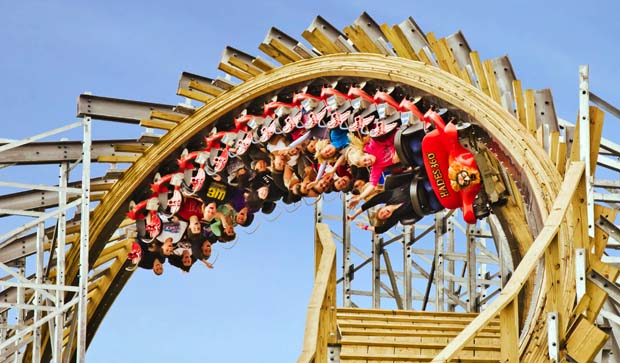Left: Topsy Turvy, London 1902
In the season when Alton Towers sets a new record for the number of rollercoaster inversions and wooden looping coasters re-emerge as a credible ride proposition, Paul Ruben takes a look at some of the notable coasters that have turned park guests upside-down over the years.
For parks seeking to establish bragging rights for their new coaster, corkscrew and looping designs have been fertile ground. Of the 93 new rolleroasters that are planned for introduction around the world in 2013, 27 will turn riders upside down at least once, or a total of 107 inversions. Fourteen of those inversions, the current standard for coaster dementia, was established this May by The Smiler at Alton Towers, Staffordshire, England.
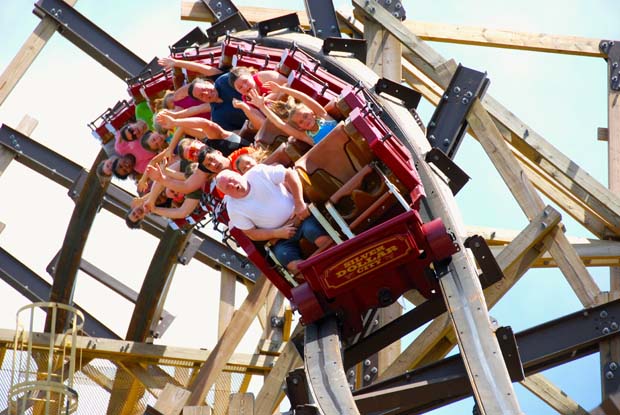
In Branson, Missouri, Silver Dollar City can now claim to the world’s only wooden coaster to twist upside down three times. With its 720° double barrel roll, Outlaw Run will draw visitors like bears to honey.
Our love affair with looping coasters has been smouldering for more than 100 years. Now it’s become a raging inferno. But going upside-down, powered only by gravity, has fascinated thrill-seekers even longer. While rollercoasters can be traced back to 16th Century Russia, looping coasters first appeared in 19th Century France.
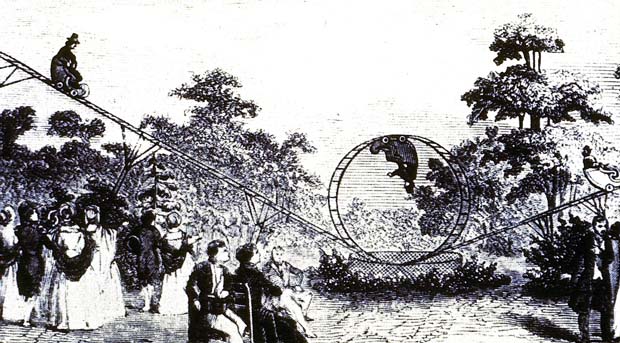
The first example of a looping rollercoaster was the Chemin de Centrifuge (Centrifugal Railway), which operated briefly at Paris’ Frascate Gardens in 1846. It was not, however, a ride intended for the public. Instead, one daredevil rode a wicker basket through a 13-feet diameter (4m) loop while their partner passed the hat before onlookers. The French continued turning riders upside down, and into each others arms on the rolling barrel-like Chemin D’Amour in 1895.
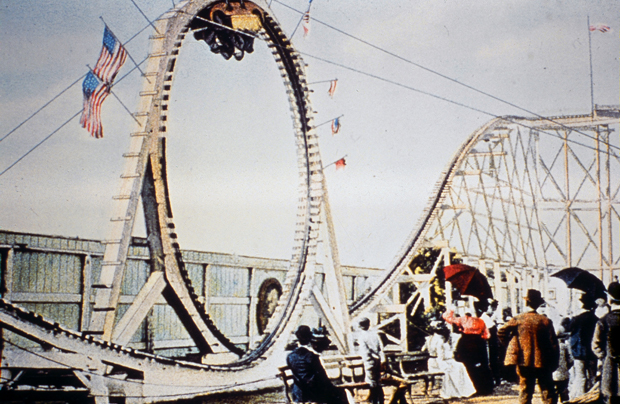
When Sea Lion Park, Coney Island, New York, opened its doors on 4 July 1895, the Flip Flap was ready for the public. Well, almost. Flip Flap riders, two at a time, would board a small car, then coast down a hill and through a 25ft diameter (7.5m) circular loop made of wood. The forces they experienced in the loop were so severe that many reported neck and back strain. As the complaints of whiplash increased, headrests were installed, but to no avail. Because of repeated injuries and low rider capacity, the Flip Flap was dismantled before the 1903 season. Other early wooden loopers soon followed such as the Topsy-Turvy Railway in 1902 at London’s Crystal Palace, but all were gone within a decade.

Interest in looping rollercoasters did not revive until after the introduction of the Matterhorn at Disneyland in 1958. The tubular steel track used in its construction had the strength to support an extended train of passengers, providing the ride capacity that Victorian-era loopers had lacked. In 1975, Bacon and Morgan used tubular steel track in the construction of the first Corkscrew at Knott’s Berry Farm, Buena Park, California.

Within a year of the introduction of the Corkscrew, the first modern vertical looping coaster, the Revolution, appeared at Magic Mountain, Valencia, California. Designed and built by Germans Anton Schwarzkopf and Werner Stengel, the loop of the Revolution differed significantly from the early wooden loops. Its shape was clothoidal, an inverted tear-drop. With a longer curve at the bottom and a shorter curve at the top, riders now experienced more uniform forces as they went head-over-heals. It quickly becam
e apparent that if one loop was good, two would be even better, so a variety of multiple-looping coasters soon appeared culminating in this year’s Smiler. And once operators realised a bigger loop is better, loop size increased, culminating in this year’s Full Throttle at California’s Six Flags Magic Mountain with a world-record 160 feet (49 m) tall loop.

Wooden looping rollercoasters re-emerged in 2000 with the opening of Son of Beast at Ohio’s Kings Island. It featured a 218ft lift hill (66.5m) and a loop made of steel, the smoothest part of the ride. It last operated in 2009 and was dismantled in November 2012 to make room for future park expansion.
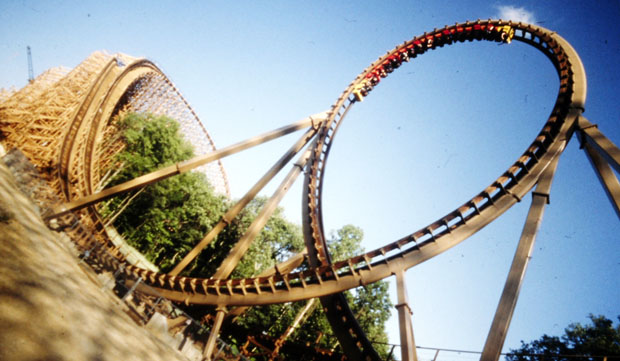
Hades, an existing wooden coaster at Mt Olympus, Wisconsin Dells, Wisconsin, was modified this year with the addition of a looping portion and new trains with underwheels in place of upstops. Both it and the appearance of Outlaw Run are expected to ignite a frenzy for more loops in wooden coasters, a new rollercoaster arms race.
